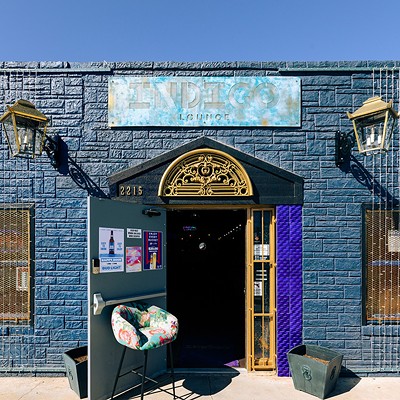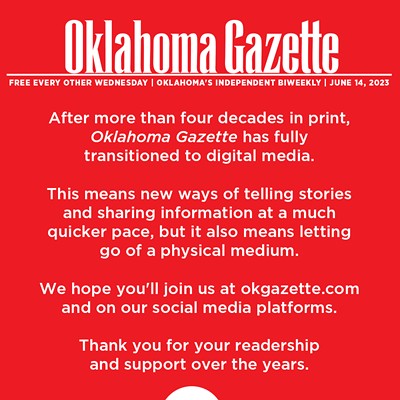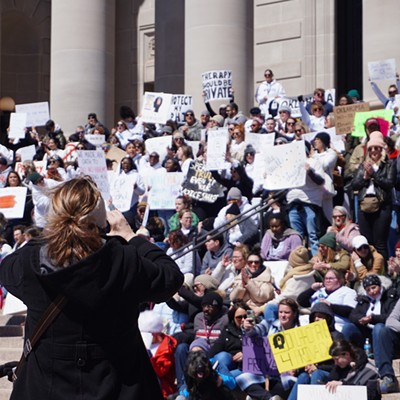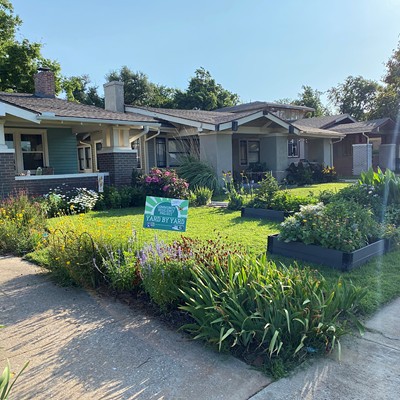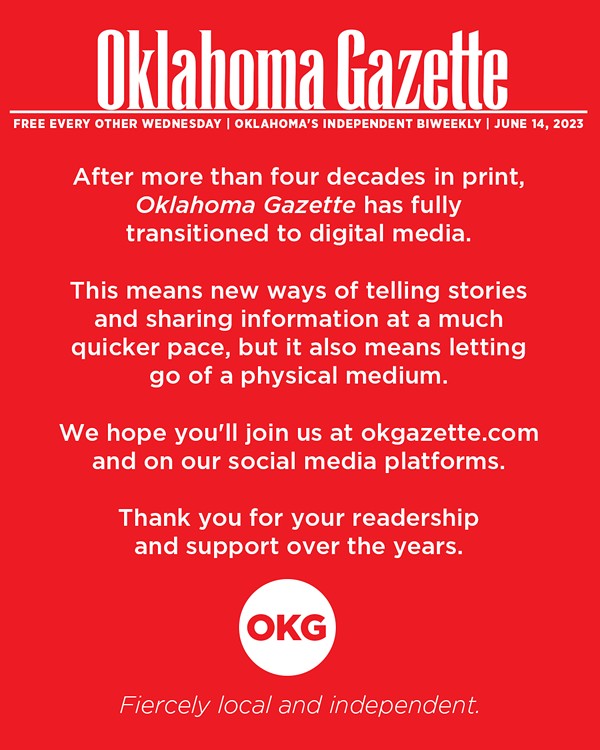Bang! A woman wearing a long black dress dropped the gun she'd fired at the pesky reporter who'd ventured too close to her Cherokee Outlet claim. She and the other women watching ran for their tents. The anonymous writer, hoping for a scoop for his Kansas newspaper, pressed on, unscathed.
STORY OF A STORY
SINGLES SEEKING LAND
A SEPARATE 'PIECE'?
BACKWARD TO FORWARD
DAISEY DOOZIE
Visiting a farmer several miles away after no inhabitant would speak to him, he learned "the village was made up entirely of women who abjured the masculine sex completely."
The settlement, "Bethsheba," had started with 33 women, but 12 left almost immediately. Another was kicked out when a razor " a masculine implement "subversive" to the ideas of the town " was discovered in her belongings. The reporter identified the leader as a Kansas woman who'd discovered her husband had a family in another state. " From Robert E. Cunningham's 1961 article in The Daily Oklahoman, "The Town without Men!"
When the dust settled Sept. 16, 1893, the Cherokee Outlet " the land promised to the Cherokee after their forced removal to Indian Territory " had been parceled out to settlers across 40,000 claims. Of the more than 100,000 people who'd registered for the largest land run " 6.5 million acres in what is now Northwest Oklahoma " up to 20 percent were women, according to historian Debbie Kindt Michalke.
Among those were a number of women without men. One of them, Syrilda Antle, went to sleep Sept. 16 thinking she'd just landed the best stretch of fertile bottomland along Spring Creek. Elsewhere, a claim on Beaver Creek offered a middle-aged woman the chance for a new life.
And, somewhere between Perry and Enid in the days following the run, Bethsheba, Oklahoma's all-women town " or the tale of it " was born. But the settlement, which periodically crops up in state history books and travel guides, has been repudiated by some scholars who claim its story has more to do with backward-thinking men than forward-thinking women.
No known descendents of Bethsheba residents exist to shed light on the tale. When the journalist returned a week later to flesh out his story, he found only prairie. A man in a nearby soddy said the women told his wife they were lonely, afraid and in disagreement.
One night, they vanished.
STORY OF A STORY
If an all-women town were to be established in an Oklahoma land run, the Cherokee Outlet posed perhaps the most fitting context. More women participated in the Outlet run than any other, according to a Sept. 7, 1893, New York Times article often attributed to female journalist Nannita Daisey, famous for the story that she leapt from a train to stake a claim near Edmond in 1889.
Women were "among the most successful of the town-site organizers and speculators," according to the article. Fourteen women planning to secure a 320-acre town site had already signed on 200 men to their initiative.
Although news stories discussing women's participation in the Cherokee Strip appear periodically in archives, Robert E. Cunningham, a contributor to The Daily Oklahoman, wrote of Bethsheba in 1961. He quoted the missing Kansas news story, and it is the closest to a primary source on Bethsheba. In what appears to be a variation of Cunningham's "The Town without Men!" in the Stillwater NewsPress, a woman who refused to be identified said she visited Bethsheba before it disappeared. She learned "the women did not make the race together." One of them had staked a 160-acre claim and others joined her as news of the "town" spread.
Cunningham, who collected newspaper clippings and wrote on regional Oklahoma history, does not name the reporter or Kansas newspaper he quotes. However, a story that ran five months after the Cherokee Outlet opening suggests another instance of women purposefully settling apart from men. A February 1894 story that eventually appeared in The Daily Oklahoman, Edmond Sun-Democrat and Cherokee Advocate acknowledged Daisey's role in the undertaking:
"Of the thirty-six women who, under the leadership of Miss Annette Daisy, made a run into the Cherokee strip when it was opened last September, twenty-two "¦ are busily engaged in perfecting a home with no man to make or mar," the Sun reported. "They hauled the lumber themselves for a house of fifteen rooms, which they now occupy, and are prepared to do their own plowing, planting, etc."
Bethsheba had already vanished. Was this some other all-women experiment on the strip? An aside at the end of the Sun's story suggests the newspaper was skeptical of the very report: "We were not aware that Miss Daisy had gone into the colony business," it comments, quipping about earlier news stories that erroneously claimed she'd been killed. "(W)e would like to know where that fifteen room house is located. The Cherokee Strip('s) 6,000,000 acres is (too indefinite)."
No sign of Bethsheba remains in those 6 million acres, either, although the town makes for a good story, admitted Kaye Bond, site director of the Cherokee Strip Museum in Perry. "I have never really been convinced that it is real, even though there are references to it in newspapers," she said. "I've never had proof that the town really existed."
What does exist, however, are accounts of women " even single women " who came to the Cherokee Outlet hoping to better their life in the midst of the drought and depression of the 1890s. Within those women's desires and experiences may rest the foundation of Bethsheba.
SINGLES SEEKING LAND
In the late 19th century, women gained ground in what long were considered men's arenas. They were being admitted to college and were making inroads into professions like journalism. In 1880, an amendment to the Homestead Act of 1862 ended years of debate and clarified, with some restrictions, that single and married women 21 and older could claim public land.
The Cherokee Outlet " and other runs " thus drew women west. Those who came without a male partner included singles eager for adventure, as well as daughters, spinsters and widows hoping to add land to their families' holdings, according to Linda Reese, history professor at East Central University in Ada and author of "Women of Oklahoma, 1890-1920."
One of those single homesteaders, Syrilda Antle, claimed the bottomland along Spring Creek in the Cherokee Outlet. Her neighbor, bachelor Sut Speer, thought he'd landed the same piece but, to his surprise, Antle was right. She built a one-room house on the land catty-corner to her sister and brother-in-law's claim and "proved up." In the Outlet, that meant paying a fee, making improvements, and living on the claim to gain title.
Like most single women who claimed land, Antle eventually married. But single women staking claims caused speculation in some quarters that their participation could be part of an effort to separate from men.
A year earlier, reporter Daisey headed a group of "eleven female 'sooners,' all unmarried women" intending to claim land in the run into what had been promised to the Cheyenne and Arapaho, according to an April 16, 1892, New York Times article, "Annetta Daisy's Amazons."
"Among these women are two graduates from Smith College, cousins, and one graduate from Monticello College, Illinois," the report states. Each woman carried a rifle and revolver, and the group was "fully capable" of fending for itself. With $2,500 between them, they intended to build a town.
"There is no man in the camp, and if the (members of the) party are accidentally discovered, they will not permit any to even visit them," the article continued. The reporter, however, made a point of noting the women did "not want a town from which the male sex is to be excluded."
A SEPARATE 'PIECE'?
Despite the newspaper's playing up the idea of the women settling apart from men, in the late 1800s it was unlikely that women, single or otherwise, would separate from family or society as the Bethsheba tale recounts. Apart from convents, Reese is unaware of any settlements in the West of the sort. At the time, she added, single school teachers weren't allowed to live by themselves, and even prostitutes were attached to a madam or male partner.
"(Women) may have camped temporarily together to avoid notice by officials, or for their own protection. They may even have chosen adjoining claims and helped each other prove up," she said. "Even so, a woman or group of women attempting a settlement on her own was a real gamble."
Some women, however, made that gamble. A New York Times reporter investigating Sooners in the Cherokee Outlet found two well-prepared "spinsters" who had sneaked away from home. On Beaver Creek, the journalist came across a "lone" woman, about 50 years old. She had hired a man to take her to the location, according to the Aug. 20, 1893, article "Sooners on Cherokee Strip," and had built a shanty with poles, twigs and dirt.
"I have been here four weeks," she told the reporter. "I came from Wichita, where I made a living for myself nursing "¦ and now I am going to make myself a home. The last four weeks of my life have been the only peaceful ones I have known for years as my husband is a frequenter of saloons and has done nothing to support me for ten years. I have no other relations on earth so far as I know, and I don't want any."
This woman's desire for a home of her own " apart from her husband " may seem reflective of the Bethsheba story. But the unnamed Kansan reporter emphasized exclusionary aspects of that community that ring extreme. When a neighboring farmer's rooster strayed into Bethsheba, the Kansan noted, "The women killed this unlucky fowl with druidistic rites."
That, according to Douglas Werden, associate professor of English at West Texas A&M University, in a recent Chronicles of Oklahoma article, is one of several clues that firmly locate Bethsheba in the land of satire, not reality.
"Only men would want to believe that women are semi-pagan worshipers seeking revenge upon all forms of maleness," he wrote.
BACKWARD TO FORWARD
According to Werden's "Stereotypes, Lies, and Crass Humor: When Men Write about Women Homesteaders in Oklahoma Land Runs," the Bethsheba story fits with other negative, fictional portrayals of women homesteaders by male writers " accounts he writes are unique to Oklahoma during the land run years and "give evidence of men's fear of women's autonomy."
"This reaction, likely a backlash against the unusually high proportion of women homesteaders "¦ was evidentially an attempt to force them out of competition with men and back into their traditional domestic roles," he wrote.
When one considers the Bethsheba story as satire, he argues its fictional nature is evident: What women separating from men would name their town after Bathsheba, the woman the biblical King David forces into adultery? Why are there no women sources? Why do Bethsheba's residents steal away at night if they are afraid, or abandon their homesteads?
"(Women) knew the value of their land and were not about to throw it away," he added.
In this light, the story of Bethsheba is not a portrayal of forward-thinking women. Women who were praised, according to Reese, were the stereotypical "sunbonnet heroines" " those who accompanied their families west and struggled to build up the land, not who separated from them and the accepted "wife, mother relationship."
"The negative images come from women who defied the accepted social standard," she said. "The implication of the (Bethsheba) story is that this is a group of misfits destined to fail, objects of ridicule rather than celebration."
Today, when newspapers supposedly purvey fact, it's easy to look askance at journalistic practices of the late 19th century. But journalism served a different purpose then, according to Dydia DeLyser, associate professor of geography at Louisiana State University, who has written on the fictional " but often considered factual " aspects of Daisey's life.
"Newspapers were entertainment "¦ because there were no movies, no television, no radios," she said. "People came to newspapers for a different thing (than today). "¦ Telling a good yarn was more important."
Where else could yarns grow into mythical proportions than Indian and Oklahoma Territory " the fringe of the storied American West? But it's crucial, according to Bond, not to lose sight of the capabilities of the real people " the Syrilda Antles and countless other women " on whom those myths are based, and who find themselves still oversimplified by stereotype today.
"There were a lot of well-educated women; women who worked hard on the farm; women who could cook or clean and raise kids," Bond said. "They had a lot of abilities, and they could accomplish a lot more than our mythology sometimes allows to women at that time."
And that, she said, applies to men, too.
DAISEY DOOZIE
In Edmond, a statue celebrates Nannita "Kentucky" Daisey, perhaps Oklahoma's most famous single woman land rusher, in her most famous act: leaping from a moving train to snatch a 160-acre homestead in the run of 1889.
However, according to Dydia DeLyser, associate professor of geography at Louisiana State University, often repeated elements of the Daisey story " that she jumped from the train's cowcatcher and used her petticoat as a tent to "improve" her claim " are embellishment, not fact.
"Daisey just jumped off the train boarding area and threw her cloak to make a fake tent," said DeLyser, who wrote an article on the topic for the journal Cultural Geographies.
The embellishment fits stereotypes feminist historians have identified of western women as "gentle tamers, sunbonneted helpmates, bad women, or hell-raisers," DeLyser wrote. The hell-raisers " who dared to take on men's roles " include Daisey and the women of the supposed town of Bethsheba.
Ironically, DeLyser discusses in her article, "Thus I Salute the Kentucky Daisey's Claim," some seemingly progressive attempts to portray women in the West " like the Edmond statue " in turn reinforce regional stereotype:
"Silenced are Daisey's real story, the contributions of other women to Edmond's settlement, and any discussion of the fact that Daisey and the thousands of others who rushed to claim land were, in fact, dispossessing Native Americans," she wrote. "Emily Jerman
Clyde Speer, and Kaye Bond and Peggy Haxton of the Cherokee Strip Museum, assisted with research.


